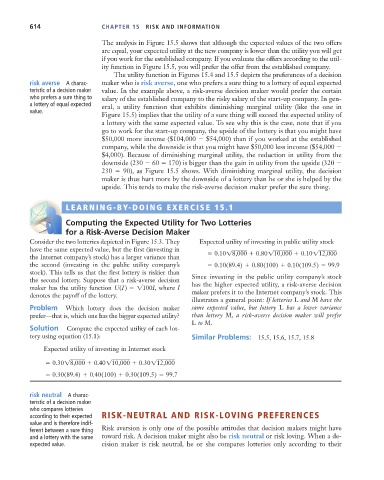Page 640 - Microeconomics, Fourth Edition
P. 640
c15riskandinformation.qxd 8/16/10 11:10 AM Page 614
614 CHAPTER 15 RISK AND INFORMATION
The analysis in Figure 15.5 shows that although the expected values of the two offers
are equal, your expected utility at the new company is lower than the utility you will get
if you work for the established company. If you evaluate the offers according to the util-
ity function in Figure 15.5, you will prefer the offer from the established company.
The utility function in Figures 15.4 and 15.5 depicts the preferences of a decision
risk averse A charac- maker who is risk averse, one who prefers a sure thing to a lottery of equal expected
teristic of a decision maker value. In the example above, a risk-averse decision maker would prefer the certain
who prefers a sure thing to salary of the established company to the risky salary of the start-up company. In gen-
a lottery of equal expected eral, a utility function that exhibits diminishing marginal utility (like the one in
value.
Figure 15.5) implies that the utility of a sure thing will exceed the expected utility of
a lottery with the same expected value. To see why this is the case, note that if you
go to work for the start-up company, the upside of the lottery is that you might have
$50,000 more income ($104,000 $54,000) than if you worked at the established
company, while the downside is that you might have $50,000 less income ($54,000
$4,000). Because of diminishing marginal utility, the reduction in utility from the
downside (230 60 170) is bigger than the gain in utility from the upside (320
230 90), as Figure 15.5 shows. With diminishing marginal utility, the decision
maker is thus hurt more by the downside of a lottery than he or she is helped by the
upside. This tends to make the risk-averse decision maker prefer the sure thing.
LEARNING-BY-DOING EXERCISE 15.1
S
D
E
Computing the Expected Utility for Two Lotteries
for a Risk-Averse Decision Maker
Consider the two lotteries depicted in Figure 15.3. They Expected utility of investing in public utility stock
have the same expected value, but the first (investing in 0.1018,000 0.80110,000 0.10112,000
the Internet company’s stock) has a larger variance than
the second (investing in the public utility company’s 0.10(89.4) 0.80(100) 0.10(109.5) 99.9
stock). This tells us that the first lottery is riskier than
the second lottery. Suppose that a risk-averse decision Since investing in the public utility company’s stock
maker has the utility function U(I ) 1100I, where I has the higher expected utility, a risk-averse decision
denotes the payoff of the lottery. maker prefers it to the Internet company’s stock. This
illustrates a general point: If lotteries L and M have the
Problem Which lottery does the decision maker same expected value, but lottery L has a lower variance
prefer—that is, which one has the bigger expected utility? than lottery M, a risk-averse decision maker will prefer
L to M.
Solution Compute the expected utility of each lot-
tery using equation (15.1): Similar Problems: 15.5, 15.6, 15.7, 15.8
Expected utility of investing in Internet stock
0.3018,000 0.40110,000 0.30112,000
0.30(89.4) 0.40(100) 0.30(109.5) 99.7
risk neutral A charac-
teristic of a decision maker
who compares lotteries
according to their expected RISK-NEUTRAL AND RISK-LOVING PREFERENCES
value and is therefore indif-
ferent between a sure thing Risk aversion is only one of the possible attitudes that decision makers might have
and a lottery with the same toward risk. A decision maker might also be risk neutral or risk loving. When a de-
expected value. cision maker is risk neutral, he or she compares lotteries only according to their

